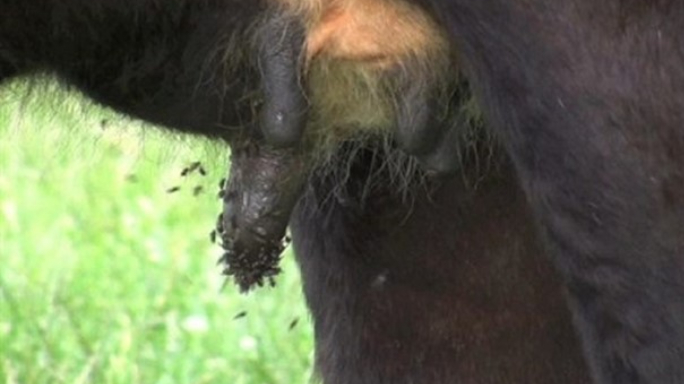What is Summer Mastitis?

Summer mastitis is a serious condition of heifers and cows and can be fatal if not treated promptly.
It is mainly caused by the bacterium Trueperella pyogenes and other bacteria can increase the severity of the disease. Flies are considered central to its transmission and hence the association with summer. Damage to the teat, trauma and irritation of the udder are also important risk factors. Summer mastitis is associated with late summer and autumn but can occur at other times of the year. The flies live in bushes and trees and only fly out to feed on cattle when wind speeds are low and in the absence of rain. The majority of summer mastitis infections occur in the front quarters of udders, and this is likely as these teats are reached more easily and that the swishing effect of the tail removes flies more from the hind teats
Clinical signs
Often the first clinical sign is stiffness when the animal is walking. Other symptoms include a swollen, painful teat or quarter, and can be easily identified by careful observation, particularly when flies become attracted to it. In most cases, once the bacteria gain entry, they produce toxins which may lead to septicaemia (blood poisoning). As the illness progresses, further signs are swelling of the hind legs, obvious lethargy and separation from the herd, abortion and even death. Some animals wall off the infection without showing any symptoms. Eventually in these cases, pus may burst out through the skin from the abscess formed within the affected quarter.
Treatment
Very few affected quarters recover, and treatment is aimed at saving the animal and the pregnancy. Treatment involves regular and repeated stripping of the affected quarter, to remove as much affected material as possible. The strippings should be carefully discarded because they increase the risk of spreading infection. Regular stripping is combined with anti-inflammatories and antibiotics, both intramammary and injectable. Oral or IV fluids may be necessary depending on how sick the cow is. Getting antibiotics to where they are needed is a challenge, as a large amount of pus is present, hence the importance of anti-inflammatory drugs. Heifers and cows with summer mastitis are best isolated to prevent the spread of the mastitis between animals.
Prevention measures
Various management practices can be put in place to help reduce the incidence of summer mastitis. The importance of having good fly control measures in place cannot be over emphasised. Flies should be controlled from early in the fly season using products containing synthetic pyrethroids which are available in pour-on preparations, or impregnated fly tags. Depending on the product used it may need to be repeated regularly, as often as every 2 weeks during the summer season. Also, the application of fly repellents around the udder area, such as traditional Stockholm tar and teat spray help reduce the number of flies attracted to the cow’s udder. It is important to avoid grazing cows/in-calf heifers in fields that have a history of summer mastitis incidences. These tend to be fields that are near rivers or marshy areas or where there is a high density of trees/ hedges where flies tend to populate. More exposed pastures are preferred as high winds inhibit fly activity. Observing and checking animals and teats on a regular basis is essential as the earlier the mastitis is detected the better the prognosis and good teat condition will reduce the risk of infection. Good hygiene measures at drying off and the use of teat sealers are essential control measures to minimise disease as the teat seal plugs the teat, preventing bacterial transfer from the environment and especially from the fly.
First Published 8 July 2024
Tagged with: Dairy